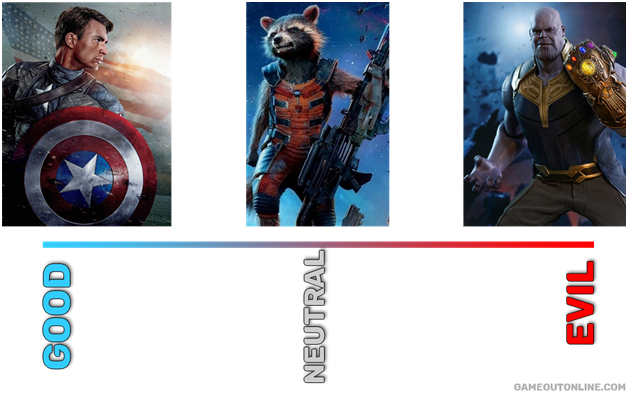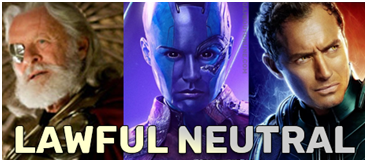What is D&D Alignment?
Alignment is a broad description of a character’s morals and beliefs. It is the core of how a character will operate, and the choices they will make. In D&D, alignment is especially important as it gives players more general structure to role-play their characters with true depth and thoughtfulness.
D&D explains alignment using lore of a multiverse called The Planes of Existence. These are realms which are formed and governed by spiritual and elemental principles that come from the mortal world (The Material Plane, which sits at the centre).

This might look a little confusing but all you need to know is that each circle is a realm which is governed by an alignment. For example, Mount Celestia is Lawful Good, Hades is Neutral Evil, etc. As you can see, each realm falls somewhere between the Positive and Negative Planes, and the Planes of Law and Chaos.
Since most of us aren’t familiar with the D&D lore of places like Arborea or Acheron, we can instead use more mainstream examples to guide our understanding of alignment. Like the realms, a Character’s Alignment can be determined by thinking about where someone would fall on these spectra of Good and Evil, and Law and Chaos.
Luckily the complex antagonists, protagonists, and story-lines of the Marvel Cinematic Universe provides us with plenty of examples that fall all over the board of alignment.
Good and Evil
Good and Evil is the more familiar aspect of character alignment. Of course, Good and Evil are very subjective words that have been debated back and forth for centuries. In the specific case of D&D character alignment though, Good characters are the ones that make decisions for the benefit of society/civilization/other people. Evil Characters are the ones that make decisions for selfish reasons, or to the detriment of society.

Captain America is generally considered a Good character because he fights for the survival and betterment of the human race. When he makes decisions, he tries to take into account how it will affect everyone. A prime example of this is in Captain America: Civil War. Despite the government decreeing that The Avengers could no longer operate, he decides that the world needs him and the others to continue on as saviors of society.
Thanos, on the other hand, is generally considered an Evil character. Although he argues that destroying half of humanity will save the other half, we can place him in the Evil alignment based on the other decisions he makes around that argument. For one thing, he sacrifices his one true love, Gamora, to accomplish his goal. He also chooses to live a peaceful and idyllic life after The Snap instead of going to Earth to face the consequences of his actions. Both of these factors indicate a level of selfishness and arrogance that speak to an Evil alignment.
In the middle of Good and Evil, you have Neutral characters like Rocket. While Rocket will often make decisions that are Good and helpful to his friends and others, he also has a bit of a kleptomania problem that gets them in trouble more often than not. When making decisions, Rocket doesn’t consider notions of Good and Evil (probably because he’s a cybernetically enhanced raccoon). He just does what he wants, or what feels right in the moment.
Law and Chaos
Law and Chaos tends to be the more difficult aspect of character alignment to understand. A big part of the confusion often stems from the concept of lawfulness. In D&D character alignment, being Lawful does not necessarily mean following the letter of the law. A character that is Lawful has a strict code (whether from religion, government, self-created, or otherwise) that they follow diligently and without fail. A character that is Chaotic, however, grates against rules and governance and will often act out in a rebellious manner.

Wong is a perfect example of a Lawful character. He can always be counted on to uphold the codes and teachings of The Masters of the Mystic Arts. Even when he befriends Doctor Strange and begins to warm to him, he still reprimands his friend when he feels that Strange is pushing the limits of natural law. Throughout all his appearances in the Marvel movies, Wong never strays even an inch from his ideals or morals.
On the complete opposite end of the spectrum sits Loki the God of Mischief and, arguably, of Chaos. While Loki is single-minded in his quest for power and the throne of Asgard, he has shown that he is highly unpredictable and will sit on either side of the battlefield, as long as it suits his needs in the moment. From mind controlling Hawkeye to pledging himself to Thanos, he has sown plenty of havoc for the Avengers and Thor. But we have also seen remarkably tender moments, like when he gave up the Tesseract in an attempt to save Thor’s life, or when he became wrought with grief over his stepmother Frigga’s death.
Between Law and Chaos, there is Neutrality again. If one doesn’t follow a written code or give into anarchy, what kind of person would that make them? Captain Marvel could be considered a good example of this. Despite her military upbringing, first on Earth then on Kree, she seemingly casts off all of these ties when she comes into her full power at the end of Captain Marvel. However, she also doesn’t possess an anarchistic nature. She still resolves to help the Skrull find a home, and gives Fury a means to contact her. This shows that, if the circumstances are right, she is willing to work with systems and regulations in order for the greater good.
Combining Forces
Now that we understand the spectra of Good and Evil, and Law and Chaos, we can begin to look at how they overlap in different characters.

Lawful Good
Examples: Captain America, Wong, War Machine
Lawful Good characters are ones that uphold a strict moral or ethical code for the benefit of society and others, despite any outside forces. They will always do what they believe is the right thing, as long as it doesn’t defy their code.

Neutral Good
Examples: Gamora, Thor, Captain Marvel
Neutral Good characters are ones that will do things for the good of others or the greater good, but not because of any particular code or law. They also do not have an inherently rebellious spirit.

Chaotic Good
Examples: Iron Man, Valkyrie, Star Lord
Chaotic Good characters generally strive to help others but they’ll do it on their own terms and in their own way. They don’t like following rules, guidelines, caution, or laws (unless it suits their purposes).

Lawful Neutral
Examples: Odin, Nebula, Yon-Rogg
Lawful Neutral characters follow their laws, codes, morals, or guidelines perfectly but without any strong moral motivation to be Good or Evil. They often seem to shun ideas of morality in order to better serve their Law.

True Neutral
Examples: The Hulk, Mantis, Vision
True Neutral characters are rare and difficult to portray. Because they have no ties to Good or Evil, Law or Chaos, they are often alien or inhuman creatures that simply exist and set themselves on paths based on those around them.

Chaotic Neutral
Examples: Skurge, Loki, Rocket
Chaotic Neutral characters are beholden to no rules, morals, or guidelines. They do what they want, when they want, and consequences be damned. Because of this, they are often the most self-serving characters.

Lawful Evil
Examples: Ronan, Corvus Glaive, Hela
Lawful Evil characters will kill and cause destruction at the drop of the hat, but only if their code dictates it. Whether that code is one they created themselves, or given to them by a higher force, they will follow it until the end.

Neutral Evil
Examples: Ego, Thanos, Ultron
Neutral Evil characters don’t care for anything except their end game. They make their decisions based on what they themselves think is best. What makes them evil is the complete lack of concern for anything, or anyone, other than their goals.

Chaotic Evil
Examples: Surtur, Dormammu, Dark Phoenix
Chaotic Evil characters are pure destruction. They only seek to destroy and cause havoc among others. Like True Neutral characters, Chaotic Evil beings are usually otherworldly, or beyond human ken because it takes extreme power and apathy to annihilate on the scale of Chaotic Evil characters.
Playing with Alignment
D&D 5e doesn’t adhere as strictly to Character Alignments as it did in the past with previous editions. In Fifth Edition, alignment is more of a description than an actual mechanic of your character, like choosing an eye color or their height. Most people will envision how a character would look like physically, but it is just as important to imagine their moral makeup.
Playing with alignment in the loose mechanics of 5e opens up a lot of possibilities for character growth and role-play. Like anything to do with human nature, alignments can shift, change, and develop over time. Alignments are also highly subjective depending on the context of an encounter.
For the most part though, you can use your Character Alignment as a baseline to determine what your character would do in different situations. How would your character react to an innocent civilian being hurt in front of them? How would your character respond to someone asking them to steal?
Next time you’re re-watching all of the Marvel movies in one sitting, keep an eye on Character Alignments and how they’re pushed and tested. What hard decisions do the characters have to make, and what inherent personality trait causes them to choose that course?
Just like how Marvel uses alignment and conflict to get you addicted to characters like Bucky, Loki and Nebula, introducing it in your D&D game will open broad dimensions to your character’s personality and growth.
Want to learn more about D&D? Visit the Library to access our in-depth guides and discussion pieces, giving you the information needed to enhance your gaming experience.





